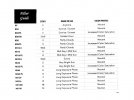It depends on what "capture" means. Are you taking a photograph or filming? Do you want or need to have cinematic blur? With a
Mavic 2 Pro TECHNICALLY, withe the
M2P's variable aperture and wide ranging shutter speeds you shouldn't need any filter at all, but might find one helpful for certain applications.
If wanting to film cinematic footage, ideally we want the shutter speed to be set at twice the frame (FPS) rate. That would probably mean setting the shutter around 1/50th sec
@iso 100. So, it would probably be advisable to have a set of ND filters and/or ND/CPL filters, up to ND64. One of the great advantages that sets the
Mavic 2 Pro above all the other DJI Mavics is the variable aperture. While the sharpest aperture settings are between f2.8 and f5.6 with the sweet spot at f4, it provides some flexibility and adjustability with selecting and adjusting to ND filters. Below I have attached a guide that might help you.
Edit: I think my favorite filters are
graduated ND filters wher ethe top of the filter is darker than the bottom. This will darken areas at the top of the screen, usually horizon/sky and less so of the lower areas so the exposure is better balanced. Polarpro had made the graduated filters but I believe no longer do so. I got luck and found a set for sale in Japan. And though they were expensive I'm happy I bought them. Right now I'm not aware of anyone making the graduated filters. Someone really should. Skyreat? Freewell? PGYTech? Are you listening?
View attachment 119055












